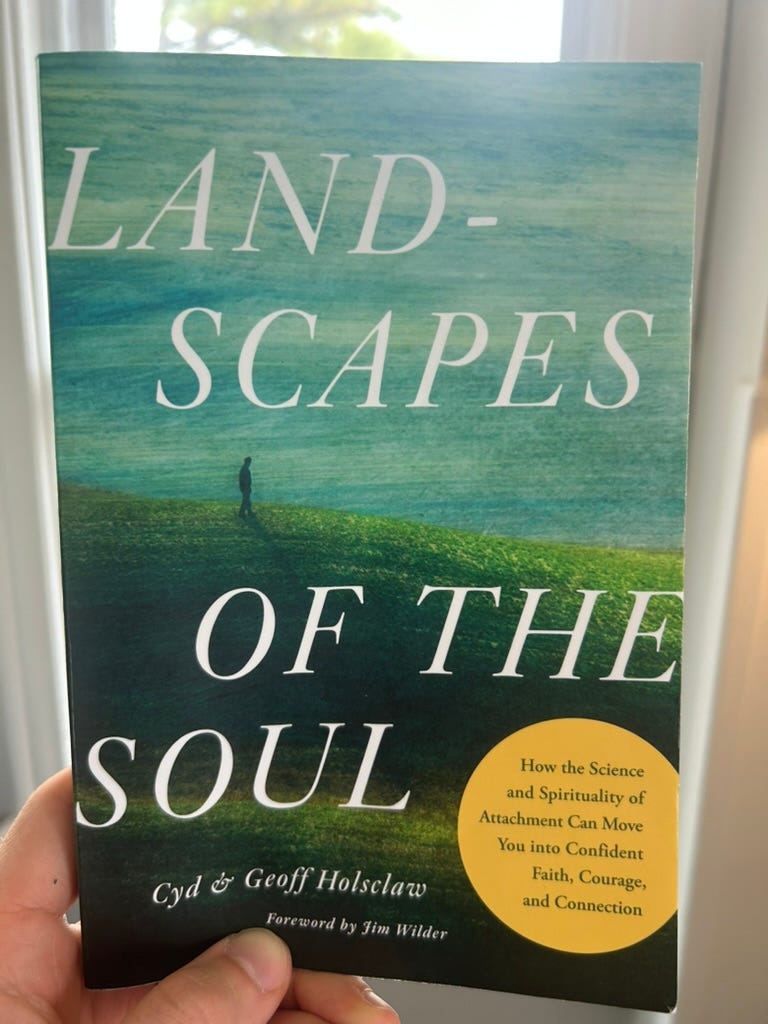Communities of Intimacy and Independence
A brief review of "Landscapes of the Soul" by Cyd and Geoff Holsclaw
Welcome to a new section of Under the Eyes of God called One More Thing Before I Close, where I’ll be sharing occasional long-form essays on Monday, based on my sermon from Sunday.
This is a space for me to either explain more than I have time to do on a Sunday morning or expound more on a specific aspect of the message that isn’t entirely relevant to my main point. I’m writing this mainly for those in my congregation who find these extra resources helpful, so thank you to those from my church for being here!
Yesterday I preached about the call in Romans 12 to “be transformed by the renewing of our minds.” We took a literal approach to this command from Paul by examining how neuroscience, specifically our attachment styles, helps us understand how we need to renew our minds so as not to be tripped up in our pursuit of Christian community.
As I mentioned yesterday, I learned a great deal on this subject from a recently released book by Cyd and Geoff Holsclaw called Landscapes of the Soul: How the Science and Spirituality of Attachment Can Move You into Confident Faith, Courage, and Connection. Geoff writes on Substack at Embodied Faith.
I’ve offered it as recommended reading to our church for our current series, “Together: God’s Vision for a Shared Life,” so in light of talking extensively about what I learned from the book yesterday, I wanted to offer a short review to encourage people in our church and my regular readers to pick up the book for themselves.
Made For Joy
As the Holsclaws explain, the incredible advances in the field of neuroscience have helped us understand how crucial joy is for our growth and development as human beings. From the earliest age, we find joy in the people, usually our parents, who are closest to us. This joy leads to secure intimacy and independence.
“Joy,” they write,
“is a relational emotion. It’s different from happiness. You can be happy all by yourself, based on circumstances. But joy needs another person - even if it is only the memory of another person. Joy is relational experience of sharing gladness to be with another person. When you are with someone who wants to be with you, it brings you joy.” (p. 20)
This idea that all of our brain development is so intricately connected to joy is revealed even more in the final part of the book, starting in chapter 10 as they depict the experiment of babies responses based on their mothers expressions (p. 126) and I could not help but immediately hear the words of Hebrews “For the joy set before Him he endured the cross…” (Hebrews 12:2).
Of course, what do I find immediately after this reference but an explanation of Jesus as the one who demonstrates what secure attachment with the Father looks like. Followed by the good news that Jesus, being in very nature God, becomes our source of secure attachment!
As we’ve been leaning heavily on Dietrich Bonhoeffer’s thinking about how the church community represents Christ to each other, this was such a profound insight to understand how the Christian community can extend joyful connection to help us grow in intimacy and independence.
Intimacy and Independence
When joyful connection is provided by our caregivers, we grow in both intimacy and independence. But the reality of sin in the world means that our bodies are marred by the effects of sin, and this includes the way we attach with each other.
We learn as infants to prioritize intimacy or independence which leads to various attachment strategies they describe as “survival skills” for living in different kinds of environments, or landscapes.
I found the metaphors of the four attachment styles so helpful for those who are not well-versed in the clinical terminology of attachment theory:
The Jungle (Anxious Attachment): High intimacy, low independence
The Desert (Avoidant Attachment): Low intimacy, high independence
The Warzone (Disorganized Attachment): Low intimacy, low independence
The Pasture (Secure Attachment): High intimacy, high independence
The goal of our life in Christian community and attaching to God becomes moving from the jungle, desert, or warzone, into a community where we joyfully help each other move towards life with the Good Shepherd in the pasture.
The second half of the Holsclaws book provides practical steps for moving into that life. I found the entire book incredibly insightful, accessible, and useful for both pastors and congregants.
What a powerful witness for the gospel we can be if we cultivate joyful communities of intimacy and independence!
I highly recommend picking up a copy today.



